 | A local history and genealogy site for Wimpole, a village and parish in South Cambridgeshire
Curated by Steve Odell
 |
Token issued by Henry Atkins (Tollgate Keeper) c1668.
Arrington Bridge Tollgate, Great North Road.
|
Token Value: Half Penny.
A local history and genealogy page for the Parish of Wimpole.
|
|
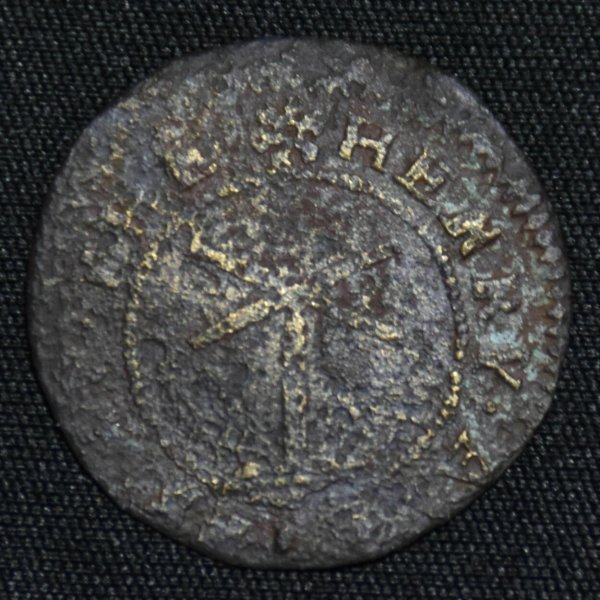
Arrington Bridge Tollgate Token (Face)
"HENRY • ATKINS • AT • THE [turnpike]" around the rim.
Depiction of a windmill within a centre circle (or perhaps a turnstile or waymarker).
(From my collection) |
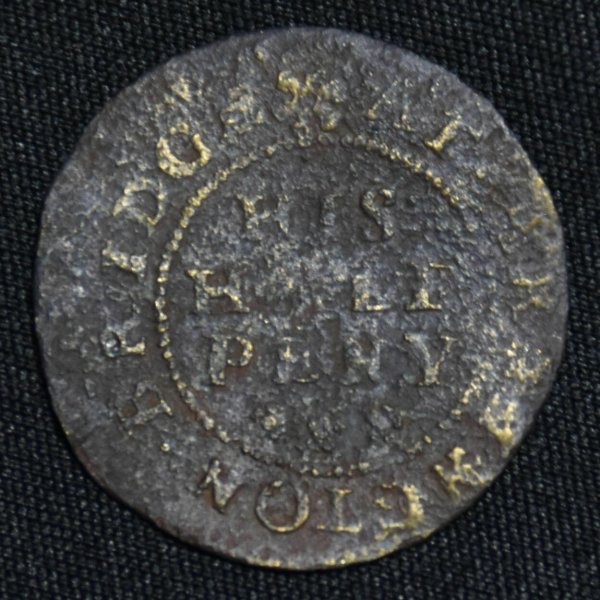
Arrington Bridge Tollgate Token (Reverse)
"AT • ARRINGTON • BRIDGE" around rim.
"HIS | HALF | PENY" within a centre circle.
(From my collection) |
 |
| Arrington Bridge Tollgate Token |
| [This page developed from a spur-of-the-moment purchase of the above token on eBay.] |
| [Above] An undated (c1668) copper half-penny token issued by Henry Atkins (Tollgate Keeper) at Arrington Bridge Tollgate on the Great North Road (Ermine Street, now the A1198). Such tokens enabled gate keepers to profit from giving change to people passing through their gate. A clean example in good condition is valued today at £80.00 [2021 price]. [1] |
| There seems to be some uncertainty among token collectors whether the image on the face represents a windmill, a signpost, a turnstile or a waymarker. |
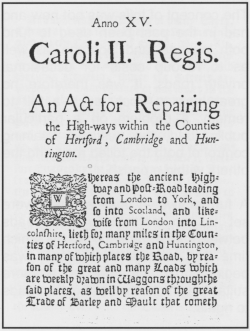 |
The first Parliamentary Turnpike Act of 1663 [left], turnpiked the Great North Road route between Wades Mill and Stilton. This was the first turnpike in England. The Highways (Hertford) 'Justice' Act the following year established the three main tollgates at Wades Mill in Hertfordshire, Arrington Bridge* in Cambridgeshire, and Stilton in Huntingdonshire (the first turnpike tollgates in England). Ogilvy's 1675 map of the route of the Great North Road shows the 'Tole barr' [sic] slightly south of Arrington.
|
| [* The site of the Cambridgeshire tollgate was originally planned for Caxton, but this location was found to be easily bypassed by travellers. The tollgate was therefore relocated south to the bridge at Arrington over the River Rhee. The River Rhee then meandered among marshland and bogs for miles either side of Arrington Bridge and through travellers on the Great North Road found they had little option but to use the gate in its revised location. In later years the tollgate was re-established at Caxton. [2] |
| Although not issued in the same year or with identical designs, 'Half Penny' toll tokens are also known for Tollgate Keepers Edward Lawrence at Wades Mill and William Flower at Stilton. The toll charge varied by traffic, but Lawrence permitted a score of sheep or lambs at the halfpenny rate with a horse similarly rateable up to as much as twopence [the general rates for Arrington Bridge are given below]. |
| Henry Atkins/Atkyns (c1630-1694?) married [first wife] Elizabeth, who died in February 1659 and was buried in Orwell Churchyard, then married [second wife] Alice Dockrie/Docwra (1636-1667) of Bassingbourn, at Harlton Parish Church on 9 October 1660. They had two children, Anne baptised Orwell in April 1663 and Frances[s] in 1666. Alice died the following year and was buried on 31 July 1667 in Arrington Churchyard. Following Alice's death, Henry was taxed for 'four hearths'. |
Notes:
[1] For further information on the token, see: David F. Wratten, '17th Century Token Issuers of Cambridgeshire', Part II, Token Corresponding Society, Vol. 5, no. 7, January 1996, pp. 252-56, and Part III, Vol. 5, no. 11, pp. 414-21.
[2]
Ref: V.C.H. Cambs. ii. 85; MSS. of H.L. n.s. v. 461–2. |
|
 |
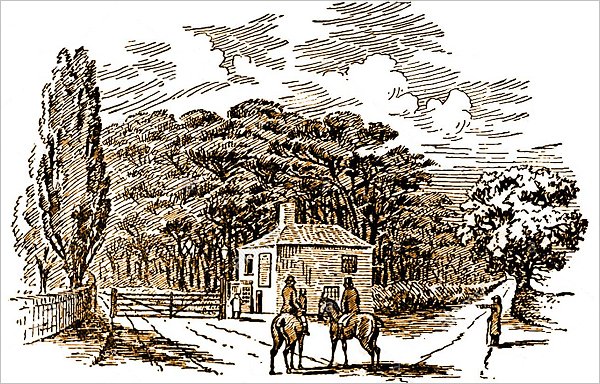
 |
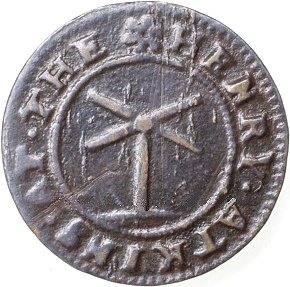 |
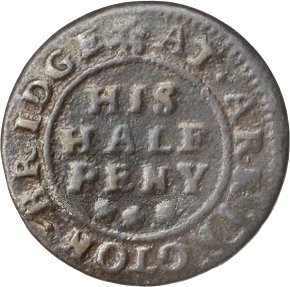 |
 |
(above) Selected pages from "A Guide for Constables" (Fourth edition, enlarged).
Published in 1674.
Collected by George Meriton, Gent. |
 |
A Guide for Constables,
|
[Text of the above pages] |
"...Churchwardens, Overseers of the Poor, Surveyors of the High-ways, Treasurers of the County-Stock, Masters of the House of Correction, Bayliffs of Mannours, Toll-Takers in Fairs, etc.
A Treatise, Briefly shewing The Extent and Latitude of the several Offices, with the Power of the Officers therein, both by common Law and Statute, according to the several Additions and Alterations of the Law, till the 22 year of his Majesties Reign.
The Fourth Edition enlarged. Collected by George Meriton, Gentleman.
London... Printed 1674."
|
"55. [paragraph slightly edited] The Collector of the Toll for these High-wayes to demand and receive Toll or Custom, for all the Horses, Coaches, Carts, Waggons, Droves, and Gangs of Cattel, that shall pass, be led, or driven in or through the Toll Gates at Stilton in Huntingtonshire, at Arrington Bridge in Cambridgeshire, and at Wades Mill in Hartfordshire, after the proportion following: That is to say,
- every Horse one penny,
- every Coach six pence,
- every Cart eight pence,
- every Waggon twelve pence,
- every score of Sheep or Lambs one half penny,
- every score of Hogs two pence,
- every score of Oxen or Neat Cattel five pence,
and so proportionably for greater or lesser numbers, and if any refuse or neglect to pay, the Collector may distrain [seize] the Horse, Coach, Cart, Waggon, Oxon or other Cattel aforesaid, or any of them, and keep them till the Toll be paid, and damages for keeping the Distress." |
| "56. Note That no Passenger is to pay twice in one day at the same place, neither is any Souldier in his March, or Post-Rider, to pay Toll, and certain adjacent Towns also to the said places appointed for taking of Toll are exempted. See the Statute it self." |
| "57. The Toll at Stilton and Arrington Bridge is to continue 11 years, to begin from the 7th of July in the 15th year of the King [Charles II so 1664?], if the ways be not well amended, and the monies borrowed paid in again, before the expiration of the said Term; and the Toll at Wades Mill is to continue for 21 years after the 11 years expired, if the ways be not adjudged to be well amended in the mean time, and all monies borrowed for that purpose, with the Interest thereof repaid again." |
| "58. The Collector of the Toll at Wades Mill is to account weekly to the Receiver General, and the next Justice may give the Collector an Oath to make a true and perfect Account, and such Account is to be returned to the next Quarter Sessions for the County, by the Justice that gives the Oath." |
| "59. All persons who by Law are chargeable towards the repairing of the High-ways aforesaid, shall still remain so chargeable, by the [requirements of paragraph?] 15 Car. 2. ch.1. and shall also pay six pence in the pound yearly, according to the true value of their Estate, towards the repair of the said High-way, during the continuance of the Toll, which shall be paid to the Treasurer of the said Toll; and in default of payment six dayes after demand, the Surveyors are to distrain [seize] for it, and sell the distress, rendring the overplus to the owners if any be." |
| "60. The Receivers or Collectors of the Toll, that shall be in the Office at the end of the 11 years, if they upon their Account shall then have any money in their hands, they are to bring the same to the Justices at their next Quarter Sessions, under pain to forfeit double so much, to be recovered by Distress and Sale of their Goods." |
|
 |
| Postscript |
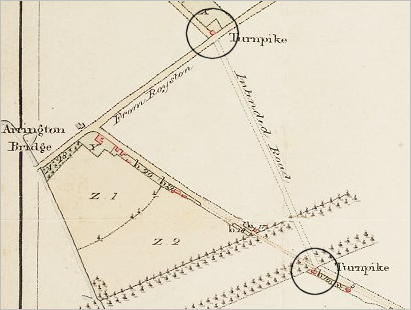 |
Estate Map 1828 (detail)
by Robert Withers |
| A brief postscript on the subject of tollgates and turnpikes. We know the location of at least two local 19th century tollgates as they are marked in red on this 1828 estate map (both marked "Turnpike" - the locational circles are mine). |
| (1) The upper tollgate above charged travellers on the turnpike administered by the Wimpole to Potton Turnpike Trust (via Wrestlingworth) which was founded in 1826. Curiously the turnpike legally started at the lower of two tollgates shown (the "Avenue Toll Bar") before running westwards. The road was disturnpiked in 1879. The old toll building (one storey, gault brick and slated roof) existed until 1968 and it's corner site is now a BP petrol station serving the A1198. Does anyone have an early photograph? |
| (2) The lower tollgate shown directly abutted the Wimpole Estate's South Avenue. It was the most westward gate on the turnpike administered by the Cambridge to Arrington Bridge Turnpike Trust which was founded in 1797. In 1837 the gate was moved further east (perhaps to the site of today's 'Turnpike Cottages' opposite Old Wimpole Road?). Cambridge Road was disturnpiked in 1870. The location shown on the above map is now the site of the Lazy Dayz Cafe and bungalow. |
|
 |
| Below is another Henry Atkins' Arrington Bridge token, this one with a clearer face than my own example. The illustrated token was sold at auction by Spink and Son in May 2020. |
|
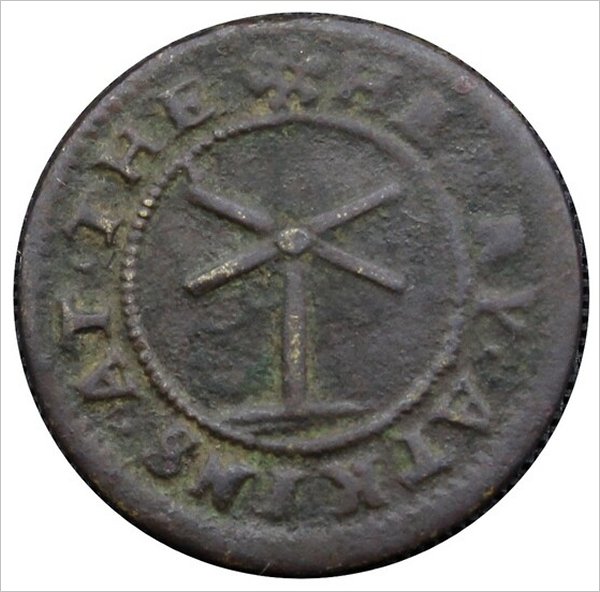
This page was last updated on: 13 March 2021.
|







